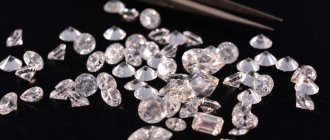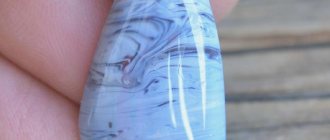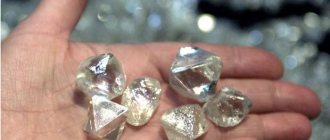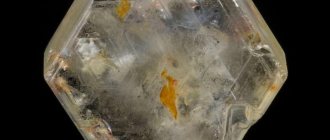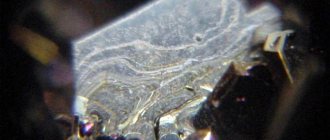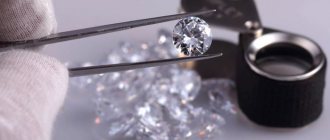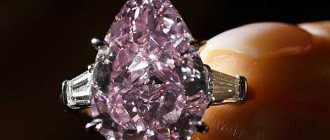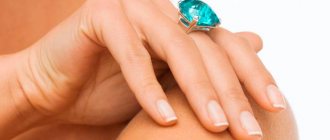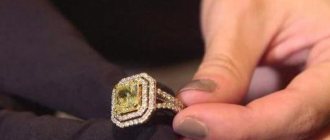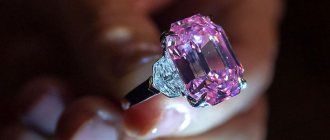What is an artificial diamond
Visually, an artificial stone is practically indistinguishable from a natural diamond, except that it is flawless - it has no chips, cracks, or impurities. A charming brilliant specimen - a crystal grown in laboratory conditions that imitate natural ones. A natural diamond, especially of jewelry quality, costs a lot of money, is quite rare, and is available only to a select few. Synthetic specimens are produced in large quantities - sufficient to cover the demand from jewelers and industrialists.
People have learned to grow carbon stones in laboratories, which are identical in hardness, density and optical properties to those formed in the bowels of the earth.
It is difficult to distinguish a laboratory specimen from a natural specimen
How to distinguish cubic zirconia from a diamond
The stones most similar to diamonds are cubic zirconias. Diamond and cubic zirconia are used for jewelry purposes and therefore, in practice, the question may arise as to what differences they have. Fraudsters who pass off cubic zirconia as precious stones use the external similarity of minerals that are completely different in chemical and physical composition. Depending on the heat treatment, it is possible to grow transparent or black cubic zirconia. Colored cubic zirconias are more reminiscent of peridots, white and pink chalcedony, red ruby, alexandrites (with inversion depending on lighting). The most important difference between cubic zirconia and diamond (except for the chemical composition, of course) is its strength and hardness. It is much softer and therefore can be easily distinguished from a real diamond even at home. So, if you run a stone across a mirror, cubic zirconia will only scratch the surface, while a natural diamond will cut the glass. You can also distinguish between a natural and an artificial diamond by its brilliance. Even a natural stone that has been used for a long time in jewelry, but becomes dirty from wear, still continues to shine, and cubic zirconia almost loses its shine. If they want to pass off cubic zirconia as a diamond for fraudulent purposes, then they try to cut it just as difficult, and then with the help of a magnifying glass or microscope you can examine and notice the “split” of the edges. This cannot happen when cutting a natural diamond. In general, it can be noted that it is quite difficult for a non-specialist to distinguish cubic zirconia if the master sets out to pass it off as a diamond. Fortunately, this is not accepted in the jewelry world, where cubic zirconia, Swarovski crystals, and other types of artificially created minerals are sold under their own names and are in fairly high demand.
Story
The history of synthetic diamond production began in 1797, when it was discovered that diamonds were made of carbon. At first, it was not possible to repeat the conditions accurately enough and the finished specimens did not have the necessary properties. The first successful experiment was recorded in 1926, but the technical process turned out to be quite complex and required improvements. In 1941, a new experimental series began, but World War II forced researchers to take a break.
In 1954, a breakthrough in the field of growing crystals occurred in Sweden - attempts to create diamonds were finally crowned with success. The laboratory managed to obtain high-quality small crystals that can be used in industry. By 1970, a method for producing large stones was developed and successfully implemented. This is how the synthetic diamond acquired jewelry value.
Over time, scientists learned to obtain in laboratories not only colorless, but also colored crystals. Nowadays blue, red, brown, and golden stones are made. Shades of blue come from boron inclusions, yellow shades come from nitrogen, and pink and brown shades come from distortion of the crystal lattice. Yellow synthetic minerals are easier to obtain than colorless ones, but creating blue ones is a significant challenge.
There are colored and colorless artificial diamonds
Cost of artificial stones
The price of 1 carat of a diamond obtained from a diamond grown in artificial conditions depends on the growing technology, type of cut, weight and color. The approximate cost of 1 carat of clear crystal starts at $800. The yellow diamond is considered the cheapest - its carat sells for $200.
The same amount of pink stone is valued at $3,000. The price of the finished jewelry depends not only on the characteristics of the gem, but also on the type of precious metal, as well as the presence of other stones.
Interesting! The price of imitations is much lower. Rhinestones are considered the cheapest, moissanites are considered the most expensive. One carat of the latter costs from $75.
Where are they in demand?
It is difficult to distinguish natural from laboratory stones, since scientists create crystals that are identical to natural ones in every way. Most of the produced raw materials go to industry and for scientific purposes. The purest samples are needed for nanotechnology and precision engineering. They are used in the construction of especially durable tools - drills, knives, circles.
Like natural, synthetic stones are in demand in jewelry. Synthetic crystals already account for more than 2% of the diamond market, and this figure is increasing.
Artificial stones are used in industry and jewelry
Industrial Application
Diamond is a stone known for its durability. The invention of synthetic diamond gave the industry new opportunities: laboratory specimens turned out to be harder, more practical, and more uniform. This made it possible to use them as a particularly hard cutting tool, including in the design of units for diamond processing.
Both natural and laboratory diamond have enormous thermal conductivity and low electrical conductivity. Thanks to this combination, the industrial diamond is an advantageous heat sink used in laser diodes and transistors. Thanks to the quality of heat dissipation, electronics last longer and require less repair and replacement. Diamond thermal spreaders are the best way to prevent semiconductor overheating.
Diamond is inert, hard, and slightly expands, so it is suitable for the output window of microwave and infrared radiation. Practice has shown that laboratory diamond is more effective than zinc selenide and silicon.
In electronics, diamond is going to be used as a semiconductor - this area of application is still being researched. Due to the high mobility of electrons, industrial diamond has dielectric properties suitable for transistors. Transistors constructed with diamonds last longer at high temperatures and suffer less from radiation and mechanical wear.
Crystals are needed in industry
WHERE SYNTHETIC DIAMONDS ARE USED
High tech
The main areas of application of artificial diamonds are industry and high technology:
- cutting tool - artificial diamonds are one of the hardest substances;
- thermal conductors - the combination of high thermal conductivity and minimal electrical conductivity makes artificial stone indispensable as a heat sink for high-power lasers and transistors;
- optics - natural diamonds are not suitable for these purposes, as they have too many defects;
Moissanite
Jewelry industry
The technological breakthrough has raised the question of the need for jewelry and diamond mining companies to control the flow of artificial stones into the jewelry market. Now the growth of their sales is limited legally. In addition to this, some companies are opening their own production of artificial jewelry diamonds.
We recommend: CHIC, SHINE, BEAUTY | How to grow NANO-SAPHIRE
That's exactly what De Beers did. The diamond mining corporation refused to engage in diamond production for a long time. However, in 2021, she created a subsidiary, Lightbox Jewelry, which began selling artificial stones under its own brand.
Artificial diamond and imitation are different things
For a layman, these terms often do not differ in meaning, but the difference between them is huge.
It should be remembered that an artificial diamond is a specimen grown in a laboratory and its characteristics are completely identical to a natural mineral. It is cheaper than natural stone, but more expensive than imitation. In terms of strength, hardness, and beauty, it is not inferior to that which appeared in the bowels of the earth.
Imitation is an attempt to make a gem similar to a diamond from another raw material. More often, diamond is imitated with moissanite, and especially cheap fakes are made of glass and even plastic.
Imitation and laboratory stone are different things
Moissanite
Although the name “moissanite” is not equivalent to the term “artificial diamond,” some unscrupulous sellers try to sell this particular stone under the guise of a diamond. The technology for creating moissanite was developed in 1905. The stone is named after the author, consists of silicon carbide and is widely used in industry. In nature, moissanite is found much less frequently; natural samples are inferior in quality to those synthesized in factories. Although quality moissanite is similar to diamond, they are different rocks with different physical and optical properties (as well as price).
Diamonds are often counterfeited
cubic zirconia
Cubic zirconia was made in the USSR in 1968, named after the Physical Institute of the Academy of Sciences. It was developed as a mineral for laser installations. Chemically, cubic zirconia is zirconium dioxide. Outside Russia it is called zirconite or jevolite. The jewelry industry uses large transparent crystals that shimmer beautifully in the light. Although a non-specialist will not visually notice the difference between a diamond and cubic zirconia, do not be deceived - these are different breeds. The optical, physical, and chemical properties of diamond and cubic zirconia differ.
cubic zirconia
Nexus
Nexus is an imitation diamond, named after the manufacturer – Nexus Diamonds. The brand creates beautiful stones, positioning them as family heirlooms that have more status than gems lying on the ground.
Rhinestones
Rhinestones, often Swarovski, are used to imitate diamonds. This is the name of crystal with an improved composition produced by Swarovski. The brand has been operating since the middle of the last century, has its own formula, produces shiny, beautiful crystals.
Swarovski crystals
Results: properties of natural diamond substitutes
Any analogues of a diamond, of course, cannot compare with it, but many people want to shine, albeit not so brightly. To summarize, we have collected in one table all the natural gemstone substitutes that are found on the market. Read about synthetic diamonds in the article “About artificial diamonds and polished diamonds.” Be careful when looking at jewelry.
Was our article useful to you? Write about it in the comments. Like and share the material on social networks, let your friends also know that an artificial diamond is not always bad.
(
5 ratings, average: 5.00 out of 5)
Fashion trends
The diamond has attracted people for a long time, which is why it was just as often imitated in the past as it is now. Previously, diamond was replaced with zircon, spinel, crystal, and rutile.
Synthetic stone analogues are an independent area of the jewelry market. The fashion for laboratory samples is growing from year to year in accordance with the ideology of responsible consumption. Since the production of laboratory crystals causes less harm to the environment, more and more buyers want to own such jewelry.
Creating stones in the laboratory - fake or not
Diamonds created artificially from synthetic materials are incorrectly called copies. This is due to the fact that identical materials are used for their manufacture, but they are obtained in different ways. A real diamond and a fake differ in that in the first case the mineral is born in nature, and in the second it comes from human hands.
You may be interested in: What is a necklace? Jewelry for women made from natural stones
Artificial stones have all the properties of real diamonds:
- high strength;
- ability to conduct heat;
- identical resistance indicators;
- pronounced shine;
- characteristic structure;
- same refractive index.
You may be interested in: Garnet stone: description with photo, properties, who is suitable for it
The only difference between a fake diamond is that it does not have any defects. Due to this feature, they are used both in jewelry production and in industry. According to statistics, no more than 20% of natural stones are suitable for use in jewelry. The remaining 80% have cracks, inclusions, and cloudiness. If you use high-quality materials when creating synthetic stones, it is very difficult to distinguish a natural stone from a fake, even with modern equipment.
Growing techniques
There are several main technologies for producing artificial diamonds. The most common is the creation of a crystal under increased pressure and heating HPHT. This method requires the use of a heavy press. It is cheap to implement, simple and gives high-quality results.
Copying nature
To implement the HPHT technology, a heavy press and a working chamber are used. The object heats up and is under great pressure thanks to the press. The stone blank is placed in the working chamber, and after a week the finished crystal is taken out. The method allows you to obtain cubes and octahedrons.
In a gas environment
Chemical deposition is a method of producing a crystal by depositing carbon from a gas suspension onto a seed. Development of the technology began in the 1980s. The method is flexible, convenient, applicable for small industrial areas, and allows precise control of the chemical composition of the mineral. Thin films are grown on large workpieces in a gas environment. The technology does not require increased pressure.
Making a diamond at home
You can create an artificial diamond yourself. To do this, use olive oil, a couple of cups, 3 graphite rods, and thread. The oil is poured into a container, a thread is laid along the diameter, the graphite is tied with it, the rod is placed on matches or toothpicks, and left for half an hour. After waiting, remove the thread, turn the container over, lay out a couple of clean rods, and oiled one on them. The slates are covered with a second container and placed in the microwave. A diamond is formed in the oiled area. During the process, sparking may occur in the furnace.
You can make an artificial diamond even at home
How to grow diamonds at home
The cultivation of “analogs” of diamonds can be organized using sugar or salt available in any kitchen. To start the experiment you will need:
- distilled or boiled clean water;
- salt;
- thread or fishing line;
- pencil.
The process consists of the following steps:
- To create a supersaturated solution: gradually add salt to water at room temperature and stir until the grains stop dissolving.
- Wind the thread around the pencil so that its end does not reach the bottom of the container. Dip the thread into the liquid.
- After a few days, the thread will be covered with crystals. You need to select the largest sample, attach it to a new thread and lower it into a filtered solution.
- Gradually the “diamond” will increase. If water stops covering the diamond, you need to make a supersaturated solution and add it to the container with the sample.
If you add food coloring to the solution, you can grow multi-colored crystals. Since all the substances used in the experiment do not pose a threat to health, you can grow a diamond from a salt or sugar solution together with your children.
How to choose
When purchasing an artificial diamond, it is important to choose carefully so as not to stumble upon an imitation. During external examination, the shine, purity, and shade of the stone are assessed. Colorless specimens without flaws are preferred. Experts advise checking the stone you like under multiple magnification - this is the only way to make sure that there are no defects. The price of synthetic diamond is 10-15% lower than prices for natural stone.
When choosing an imitation diamond, it is preferable to take moissanite. Its optical and physical parameters are closest to natural stone.
Origins of synthesis
Harvard University professor P. Bridgman was at the origins of diamond synthesis. Thanks to his research, it was possible to carry out a “magic transformation” and obtain an artificial mineral from graphite powder. Tracy Hall, a member of the General Electric laboratory research group, was the first to achieve this.
The scientist took part in the development of high-pressure equipment for the production of artificial diamonds. Subsequently, such a system was created and called “halfbelt”. The first experiment was successful on December 16, 1954. It was possible to obtain artificial stone under conditions of increasing pressure to 70,000 atmospheres at a temperature of 1600 °C from graphite and troilite.
Diamond production technologies
Nowadays, several technologies are used to produce synthetic stone, each of which has its own characteristics. The most reliable, but most expensive technology is to produce diamond from crystalline carbon, which is placed in a special press for processing. First, water is supplied to the material being processed using powerful pumps. This creates high pressure. The water then freezes under the influence of the refrigerant, causing the pressure to increase up to 10 times. At the last stage, the chamber containing the carbon is connected to the electrical busbars and a powerful current is supplied for a few fractions of a second. Under the simultaneous influence of temperature and pressure, graphite is transformed into hard stone. After this phase, the press is defrosted, the liquid is drained and the finished artificial diamond is taken out.
Difference between scientific and popular names
Many scientists have worked in the field of imitation diamonds. “Made in the USSR” - this marking can be seen on precious jewelry with “diamonds” from the times of the Soviet Union. In the area where they are actively involved in the “growing” of synthetic stones, they are named according to production technology.
You may be interested in: How to clean a silver cross: effective methods, remedies
If the creation involves high pressure and temperature, then the abbreviation HPHT is used, and the CDV marking indicates that the chemical vapor deposition technique was used. An imitation diamond does not always act as its full copy. In common people they are better known as cubic zirconia, moissanite, rhinestone, ferroelectric, rutile, fabulite. However, the most popular is zirconium dioxide, which has no similarities with a real diamond.
Out of ignorance, most people call all fake stones cubic zirconia. Naturally, such a definition cannot be considered correct. However, it does an excellent job of simulating diamond, since it glitters in the sun and shimmers with colors, which is due to its high refractive power. Due to this, cubic zirconia is often used in jewelry.
